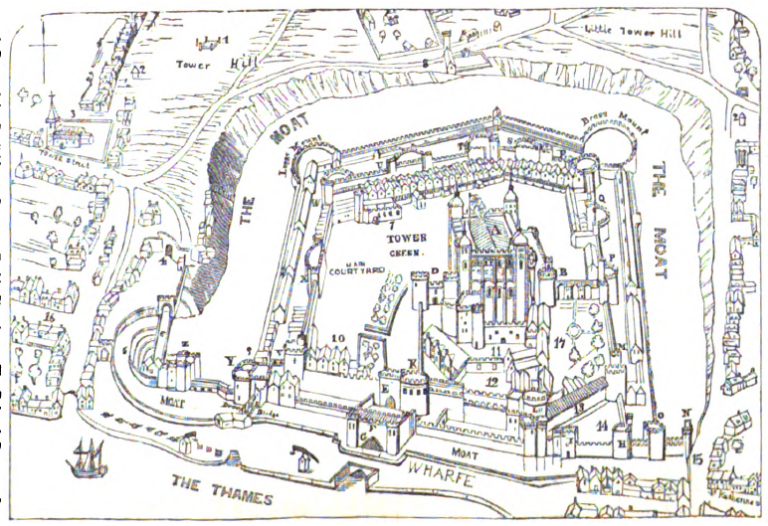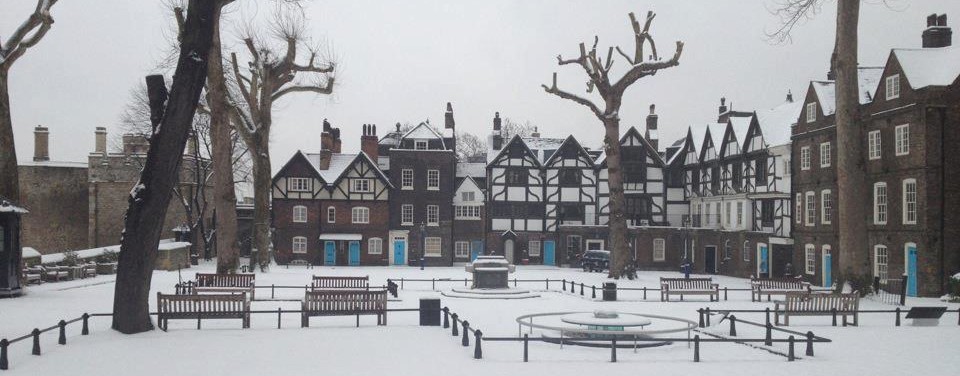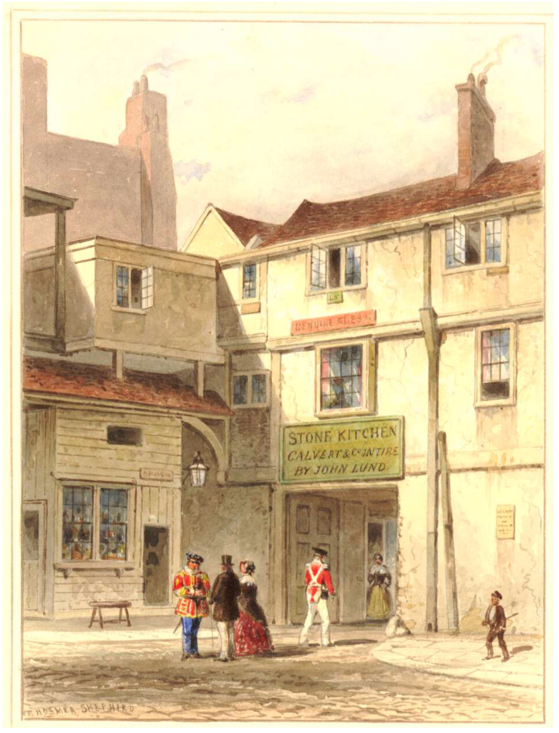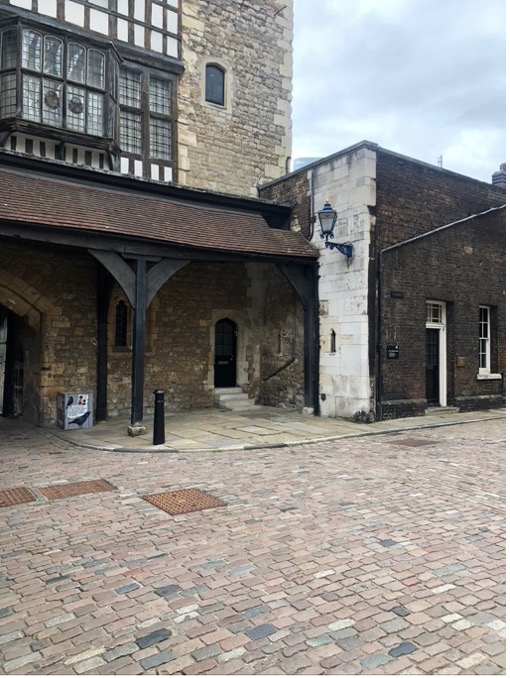This is not finished
There were probably areas in the Tower in the Medieval period were food and Ale were produced. In these days a Pub would be a social meeting place not essential to life although this has not always been the case, and in the Tower surrounded by water that could not be drunk, people drank alcohol the boiling in the production would have made it safe to drink, and a central area for the preparation of food, keeping fires to minimum.
Before going further I would need to clarify some terms, A “Pub” or Public House, is an establishment that would sell alcohol and food, a Tavern would also sell alcohol and food as well as provide accommodation. Although in the late 17 and early 18 century the term Suttling was used in the Tower, which a very military term for a Tavern. So the term Suttling is used but as the Tower moves into the 19 century, the Tavern is then used.
During the Tudor period things become clearer, the walking into the Tower on the left (No.1 The Casemates) “The Stone Kitchen”, West of the Bell Tower and again South of the Bell tower another Tavern, “The Bunch of Grapes” the picture shows locations Taverns in the Tower and the locations of Yeoman Warder accommodation from the 18 and century, also the Yeoman Warders Club today.
 These Suttling were an unofficial and accepted way for the Tower, Lieutenant to make money renting buildings,
These Suttling were an unofficial and accepted way for the Tower, Lieutenant to make money renting buildings,
General Vernons comments are quite telling as these would be for used of the Tower garrison, not really Yeoman Warders, in 1683 there are 40 Yeoman Warders of which 17 live in the Tower and by 1715 there are 37 Yeoman Warders which 15 live in the Tower. During the 18 century there are 3 Suttlings, The Stone Kitchen is still open West of the Bell Tower in the area of No. 1 The Casemates. South of the Bell Tower The Bunch of Grapes now called Warders Hall, and the Golden Chain, and a fourth around the Queens house, although this might be purely for Lieutenant of the Tower and Officers.
In March 1729 the Warders Hall is run by the Yeoman Gaoler, extract from Williamson Diary:
As we move into the 19 century contrary to Ian McInnes book “Yeoman of the Guard” in which he states there are six or more Taverns in the Tower. Reading through the Rates Books and Census, there were actually three, one owned by the Yeoman Gaoler Lund (Stone Kitchen) and another by Yeoman Warder Sutcliffe (The Golden Chain) and one by a Mr George Tidy. In 1845 the Constable of the Tower Duke of Wellington closed all the Taverns and opened a central canteen for the feeding of The Garrison, this did not really affect the two Yeoman Warders but it did have dire circumstances for Mr Tidy and family.
Extract from the West Kent Guardian On the 5th December 1846:
“Reported an Extraordinary Suicide at the Tower About 4 O’clock on Sunday afternoon a most destressing case of the case of suicide occurred in the Tower under the following peculiar and painful circumstances up to a few months since, three public houses were licenced in the Tower one which namely the stone kitchen which is an ancient as the time of Henry VIII was occupied by Mr Lund Yeoman warder of the fortress. Another victualler, licence for the tower named Sutcliffe who received notice under the new regulations that his house called “Golden Chain” close to the iron gate must also be done away with on the opening of a new canteen (for the Military to eat). As both these parties were more or less under the influence of the authorities of the Tower they quickly succumbed to the new regulations though at an immense sacrifice. The deceased George tidy who was also a licenced victualler in the Tower but not all responsible to any of the authorities right resisted the order up to the last and imagining that his length of holding gave him a prescriptive right such as any citizen would enjoy in any loyalty where he had expended his whole capital in establishing his trade refused to obey the injunction finding however that the order was imperative and fear to meet the consequences which he felt must be ruinous in anyway at 4:00 o’clock on Sunday last after having exhibited for some time symptoms of a great mental distress and frequently said he would never be taken out of the house alive he cut his throat in his bedroom afflicting a most frightful gash. Application was made to the nearest surgeon but life was quite extinct and all hope of reanimation abandoned”.
The canteen that the Duke Wellington established later in 1920 became the Navy Army Airforce Forces Institute (NAAFI). No more alcohol was sold in the Tower, which left the “Tiger Tavern” outside the Tower a very sort after watering hole.
There was a NAAFI canteen established in the Guard room and when that was destroyed by fire, the canteen moved to the White Tower. After the War the Yeoman Warders had a club, which was originally open in the area of the previous Warders Hall South of the Bell Tower, when that moved to its present location is unknown.
The Tiger Tavern
 Although the Tiger Tavern is outside the Tower it has provided food and drink for people inside the Tower, since 1500. A story that when Princess Elizabeth was imprisoned in the Tower by her half-sister, Mary. She had her meals provided by the Tiger Tavern, and one night she sneaked out for a night in the Tavern, hence the notice on the front.
Although the Tiger Tavern is outside the Tower it has provided food and drink for people inside the Tower, since 1500. A story that when Princess Elizabeth was imprisoned in the Tower by her half-sister, Mary. She had her meals provided by the Tiger Tavern, and one night she sneaked out for a night in the Tavern, hence the notice on the front.
BUNCH OF GRAPES (WARDERS HALL)
Going into the Tower another Tavern from Tudor times, would have been on the right as entering the Tower through the Byward Tower, Bunch of Grapes Tavern, although it is believed to have medieval origins and was situated on the cross wall on the south side of the Bell Tower (Ref required). This building was originally attached to the Bell Tower, and much larger, this was taken down or closed in 1796. There was also a Tavern called the Bunch of Grapes on Tower Hill.
The Tavern in the Tower later became known as the Warders Hall, they had someone run it on a day to day basis, a Mother Thomas who on the 17 April 1736 dies:

The Wharf Bridge, was a drawbridge connecting the Byward Postern gate with the Wharf, Williamson Diary Page 91
STONE KITCHEN
Another Suttling or Tavern open since Tudor times is the “Stone Kitchen”, which was located across the street on the outer walls, West of The Bell Tower, again originally connect to the Bell Tower. In 1597 Sir John Peyton complains of enduring ‘a Comon Brewhouse, and Backhouse to bee kept within ye mint’ suggesting near mint offices ( (Keay 2001), p.29 citing Bod. Lib, MS Eng Hist e 195, f. 5v)

The map of the Tower from 1533, only shows one Tavern the Stone Kitchen (No. 9) North of the Byward Tower (Y) (Curiosities of London Page 726)
GOLDEN CHAIN
At the other end of the Tower is the Golden Chain, sometimes the location is said to be in the Salt Tower and others South of the Salt Tower, seems to have been opened during the 19 century.





1 responses to Tower of London Taverns
Good afternoon,
I have just read your website after not finding one for such a long time and I really appreciate the information given out and the time devoted to it.
My family story says that our ancestor ran/lived at? the Stone Kitchen. His name was William Page, wife Hannah, and I am talking of ca1788. The children were baptised in the nearby church All Hallows Barking.
I do wonder if you have any more details of the persons who were involved in this establishment.
I live in Hobart, Tasmania and my immigrant ancestor Joseph William Page reached these shores in 1850 as crew of the Hyderabad.
I know it is a hard ask and there may not be any information to give. Thank you for your time.
Louise Rainbow
Leave a reply to Tower of London Taverns